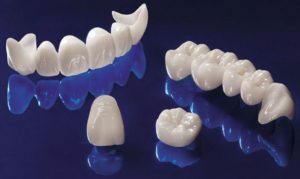 A modern and promising direction of dental prosthetics is the use of non-metal ceramics. This technology of creating dental structures gave impetus to the development of aesthetic dentistry.
A modern and promising direction of dental prosthetics is the use of non-metal ceramics. This technology of creating dental structures gave impetus to the development of aesthetic dentistry.
prostheses made of ceramic mass of high strength without metal content, is completely harmless because they have a high level of biocompatibility and highly aesthetic since the use of advanced processing technology of ceramic materials.
Content
- Features of use of ceramics in prosthodontics
- Types of products derived from ceramics
- advantages of all-ceramic prosthesis
- Manufacturing and installation of products
- Indications and contraindications for the use of ceramic
- Thoughts patients dental clinics
- What cost new teeth?
Features of the use of ceramics in prosthetics
The feature of non-metal ceramics is the complete absence of metal and the use of ceramics for the manufacture of prostheses. This ensures the ease of construction and reducing the load when chewing food on adjacent teeth.
Metal-free ceramic allows to exclude the presence of allergic reactions of the oral mucosa on the metal in the patient.
Porcelain is a rather brittle material, however modern methods of processing of non-metal ceramics allow to achieve strength of these 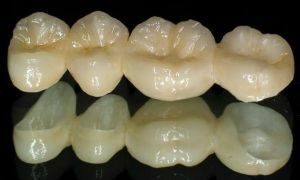 products due to the inclusion of zirconium and alumina frameworks in the base. Therefore, such prostheses can be installed not only on the front incisors, but also on the chewing teeth.
products due to the inclusion of zirconium and alumina frameworks in the base. Therefore, such prostheses can be installed not only on the front incisors, but also on the chewing teeth.
Due to the property of transmitting light and the possibility of selecting a shade of ceramic products, such prostheses imitate hard tissues of natural teeth, giving them a lively and natural shine. That's why ceramic teeth can not be distinguished from real teeth, and they do not change colors during the whole life.
Ceramics differs from other products for a period of more than 15 years. The length of the period is also conditioned by the fact that the ceramic teeth are resistant to the effects of food dyes, liquids and do not absorb odors.
These distinctive qualities of modern ceramics make it possible to use it for solving various problems of dentistry, from chips and damages to complete restoration of the tooth.
Types of ceramic products
Ceramics, in view of its strength and reliability, is used to make:
- crowns or inlays;
- veneers or laminates;
- prosthesis.
Ceramic crowns are frameless porcelain products that differ in their aesthetic qualities and are ideal for restoring central incisors and canines. In some cases, ceramic crowns allow you to keep the remainder of the living tooth.

The photo-ceramic veneers - ideal for installation on the front teeth
for complete or partial recovery fillings, crowns or tooth generally use special ceramic inserts.
Ceramics also is a versatile material that is used for manufacturing onlays and veneers, which are a special plate on the front part of the tooth, or allow to hide some of its shortcomings.
In case of total loss of tooth used non-metal orthopedic devices that are using special hooks and bridges connected to the adjacent teeth or implants are placed on which are implanted in the maxillofacial bone. As
looks and how to set a tab ceramic:
advantages of all-ceramic prosthesis
main advantages of all-ceramic that distinguish it among other types of prosthesis is:
- achievement of the flawless appearance of due to the properties of light transmission, the possibility of color correction
 orthopedic product and the identity of the size of the lost tooth;
orthopedic product and the identity of the size of the lost tooth; - no visible gingival margin of the ;
- the presence of a perfectly white tooth surface , which reduces the risk of caries and plaque formation;
- color fastness , which with time does not change and does not stain;
- does not react with liquids and is not oxidized by ;
- use of safe materials that are biologically compatible and do not cause any allergic reactions ;
- possibility of installation both on the front incisors and on the chewing teeth of ;
- strength of porcelain products , which is largely superior to metal;
- ease of prosthesis makes it possible to significantly reduce the load when chewing food on adjacent teeth;
- has good thermal insulation properties of , which makes it possible to enjoy beverages of different temperatures;
- no need to remove the nerve due to the small thickness of the inserted crown;
- the possibility of manufacturing linings, veneers and prostheses of various shapes and thicknesses, which largely excludes the possibility of injury to the tooth or gums;
- more gentle dissection of your own teeth ;
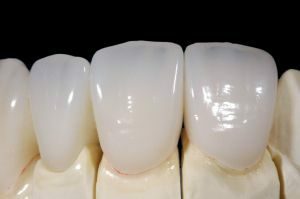
- use of high-tech technology , which with the help of computer technology make it possible to produce a solid base for the ceramic frame;
- The ease of use of and the rapid addiction to the prosthesis due to its lightweight design;
- durability of use with preservation of aesthetic, strength properties of the product and its ideal edge fit;
- availability of the procedure in view of for the relatively low price of for the use of ceramic implants.
Manufacture and installation of
products The process of manufacturing elements or whole teeth from non-metal ceramics assumes:
- imaging, laser scanning and computer modeling of the jaw for this impression;
- manufacturing with the help of a milling machine of a skeleton from ceramics;
- baking of finished carcass in a special oven;
- layering of ceramics on the frame;
- polishing and glazing of the element.
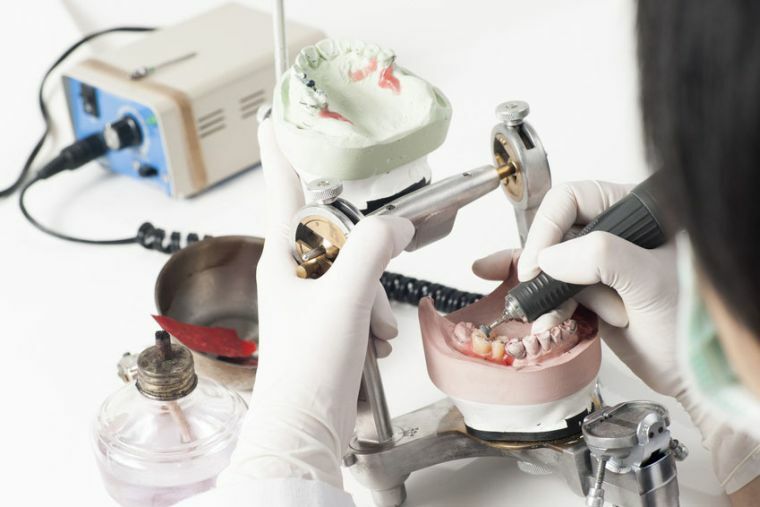
Before installing inserts, lumineers, veneers or crowns, the doctor carefully examines the damaged tooth, conducts measures to extract substandard seals, grind the tooth to the required thickness of the inserted product and all the necessary treatment complex.
If the goal is a complete restoration of the tooth, then the implant is implanted, followed by the preparation of the basis for a complete restoration of the tooth. A feature of the use of false teeth from nonmetallic ceramics is that this method of prosthetics does not provide for processing and loading of neighboring teeth.
For this, the implant is placed directly into the gum. If there is almost no entire dentition, then a beam structure or removable dentures can be used.
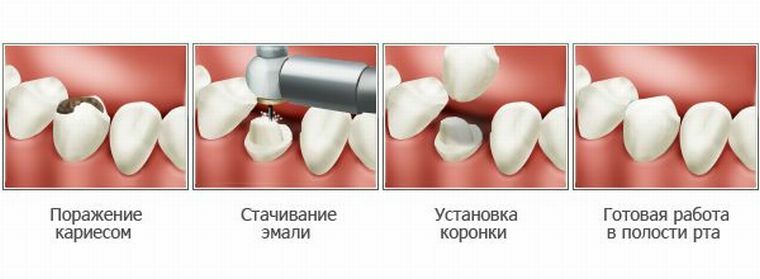
Next, the impression is taken and the color of the product is selected on a special scale, which corresponds to the natural shade of the patient's teeth. A sharpened tooth is coated with a plastic analog for the time of making a permanent crown.
After the crown is made, the dentist withdraws the temporary denture and installs the missing element with chemical-cement cement.
Indications and contraindications for the use of ceramics
The list of indications for the installation of non-metal ceramics is as follows:
- tooth restoration and its correction;
- alignment of the dentition;
- for allergies to metal products;
- correction of defects and damage to teeth.
Contraindications are as follows:
- deep occlusion;
- bruxism;
- weakened immunity;
- bone disease;
- presence of inflammatory processes in the oral cavity of the patient;
- during pregnancy.
Thoughts of patients of dental clinics
Metal-free ceramics has found recognition among patients of stomatology clinics, which is confirmed by numerous reviews.
I made myself prosthetics of the front teeth with aluminum dioxide. For a year I have been wearing dentures and I am very pleased with them. Of course, I do not gnaw on them, I do not bite off the frozen chocolate, but otherwise there are no problems.
Unlike cermets, which is on my chewing tooth and metal began to shine through, metal-free ones can not even be distinguished from their own. The doctor warned - if they take care and care, then for 20 years I can forget about the problems with their new native teeth.
Oleg
My husband delivered metal-free ceramic teeth. Everything is fine, eats everything that the soul desires. But, he thought to gnaw the dice and the crown crumbled. But the doctor warned. I had to re-put, what can you do. After that, we banned him his favorite delicacy, and in the end, for 5-6-7 teeth, ceramics kept him for 7 years!
Olga
My mom put four crowns of zirconium. But before that she had to suffer a little, becauseBefore the installation of metal-free teeth, plastic crowns were installed for 2 weeks.
All this time she was aching pain, but when she installed ceramics on zirconium oxide, she did not even feel any discomfort. Let's hope that for at least 15 years, she can use them and admire them.
Marina
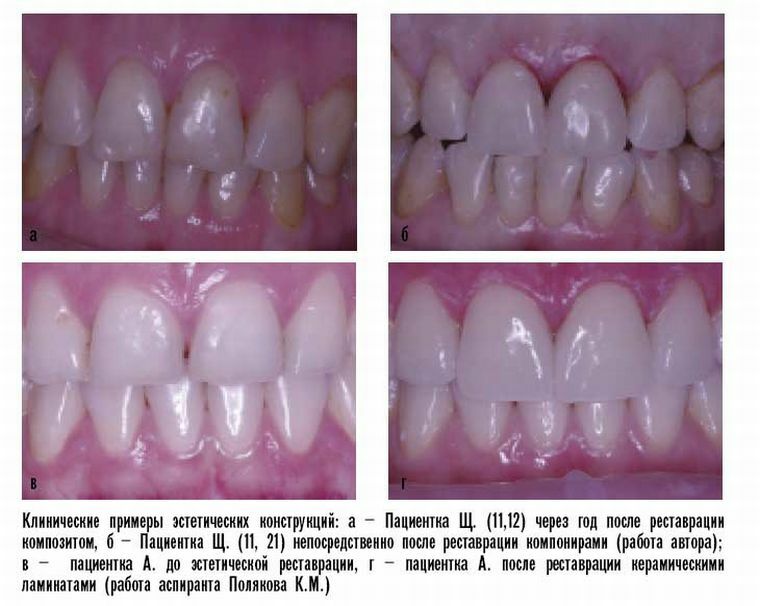
What will the new teeth cost?
Cost of prosthetics depends primarily on the clinic. An important role in the formation of the cost of such services is the technology of manufacturing, labor input and costs for materials for their conduct.
Installation of the exact cost can be announced only after carrying out all the works. However, it should be warned that prices for non-metal ceramics are high enough and the cost of prosthetics can fluctuate within the range of $ 100-350.
The most perfect method of dental prosthetics today is metal-free ceramics, which has significant advantages over other methods of prosthetics.
Lightweight, durable and reliable ceramic products give an opportunity to achieve an aesthetic effect and in time to preserve the integrity of the native teeth. Do not hide your smile!
